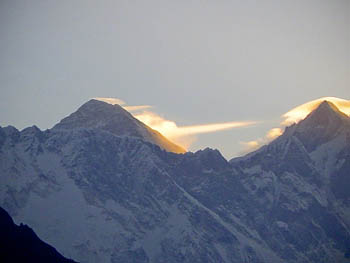 Earlier this year, a small team of climbers made it to the top of Mount Everest. What marked them out from the crowds of summiteers was that they had more in mind than simply standing on the roof of the world.
Earlier this year, a small team of climbers made it to the top of Mount Everest. What marked them out from the crowds of summiteers was that they had more in mind than simply standing on the roof of the world.
Everest shows its awesome beauty as sunlit cloud streaks from its ridge
Their mission in climbing to the top of the Himalaya was to get to the bottom of why some people survive life-threatening situations and others perish. Their findings may yet save hundreds of lives across the globe – for patients in hospital intensive-care units as well as high-altitude climbers who push their luck.
The Caudwell Xtreme Everest expedition, named after former Phones4U boss John Caudwell who put up a substantial amount of cash for the project, was led by Dr Mike Grocott of University College London. It succeeded in setting up the highest ever medical laboratory and undertook research into how the body copes with low oxygen levels found at altitude.
The results will have far-reaching consequences for how patients are treated in high-dependency units, where casualties often face the same problems as Himalayan mountaineers. Nearly all intensive-care patients suffer from low oxygen levels. 20 per cent of patients will die in these units. Doctors do not know why some patients cope better with hypoxia – low oxygen and others succumb. Hence Xtreme Everest.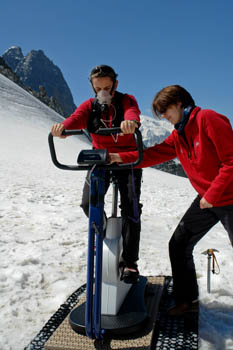
The BBC’s Horizon team filmed the event, and two programmes were recently shown. There’s background information about the broadcasts on the BBC’s Doctors in the Death Zone section of the Horizon pages.
But the expedition was much more than a few high-profile extreme mountaineers conquering the peak. Along with the medics tackling the summit, 200 volunteers paid more than £2,000 each to join the experiment: their goal, to trek to base camp and act as guinea pigs for the collection of a huge amount of data on how the body adapts to altitude. Their experiences were, in many ways, almost as hair-raising as the summit team.
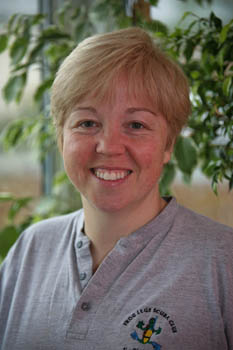 Many of the volunteers were, like the mountaineers, health workers. One such was Jacqueline Figgins, a 40-year-old intensive-care nurse who works at a hospital in Yorkshire.
Many of the volunteers were, like the mountaineers, health workers. One such was Jacqueline Figgins, a 40-year-old intensive-care nurse who works at a hospital in Yorkshire.
Jacqueline Figgins
Jacqui is a keen walker – the expedition demanded that participants be fit – but had done no altitude work before. The experiments began long before the trek: participants had tests in London before setting out and were to undergo frequent examinations throughout their time in Nepal.
After tests in the capital Kathmandu, Jacqui’s party clambered into a 16-seater plane heading into the high mountains. The landing at Luckla has to be done before 1pm before bad weather sets in. Heathrow it’s not: cows used to graze on its strip before it was asphalted. It’s still an experience coming in to the airstrip.
Jacqui said: “We landed on this hairy strip where you don’t think you’re going to stop in time. You just turn right and you’re in this flat area. Only one plane can land at any time.
“I had altitude sickness straight away. I could hear my head pounding, within ten minutes. I was paranoid then. I’d never been to altitude before. I’d always wondered: would I feel the effects, would I be different? But everyone feels them most of the time. And I basically felt off all day and then next day I was absolutely fine. It was obviously just the step up to Luckla which tipped the balance for me.”
Jacqui’s 69-year-old father William Figgins also went on the expedition, but he wasn’t the oldest: a 73-year-old had to return to Kathmandu after catching a severe chest infection.
The flight to Luckla was preceded by a stay in Kit Spencer’s Summit Hotel in the Nepalese capital Kathmandu, a chance to mix with the many climbers and trekkers on their way both to and from Everest. Base camp trekking and even summit ascents are big business now, with thousands taking part every year. Luckla, which once had just a few flights each day, now has a plane landing every few minutes.
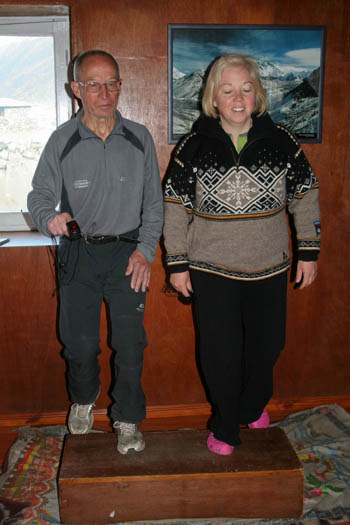 The Horizon footage shows summiteers and base-camp trekkers alike performing what was to become a Himalayan ritual for all those involved: the step test. “In the morning, we had to do a step up, like ladies do in the gym,” Jacqui said. “We had to do the step-ups for two minutes every single day. We took the step with us – a porter carries it. You measure your oxygen, your heart rate and your breathing as you go higher. That’s part of the research.”
The Horizon footage shows summiteers and base-camp trekkers alike performing what was to become a Himalayan ritual for all those involved: the step test. “In the morning, we had to do a step up, like ladies do in the gym,” Jacqui said. “We had to do the step-ups for two minutes every single day. We took the step with us – a porter carries it. You measure your oxygen, your heart rate and your breathing as you go higher. That’s part of the research.”
Next major stop after Luckla was Namche Bazaar, where the trekkers had three days rest before continuing. Even here, there were reminders of the dangerous nature of the Himalayas. Jacqui said: “In our grounds, was a crashed helicopter. We were 100m from the army barracks which was there to fight off Chinese coming over from Tibet.
“The helicopter had crashed in bad weather right next to the prayer flags. This was a great big helicopter, like you see in M*A*S*H.”
For light relief, the different teams involved staged photo competitions. “One of the groups had climbed into the helicopter, put their expedition gear on that we’d all been given, and hung out of the wreck like dead bodies.
“So we said: ‘What can we do? What can our group do? We’ve got to do something’.”
A trawl of the various stores and stalls of Namche resulted in enough fake gear and tourist tat for some judicious positioning to produce a replica of the WI naked calendar.
Jacqui said: “We came up with the Calendar Boys and Girls. We kept it a secret from the guy who was the manager of the research lab, who was a really outgoing guy called Monty. He was speechless! We were in the basement of our lodge and it was freezing.
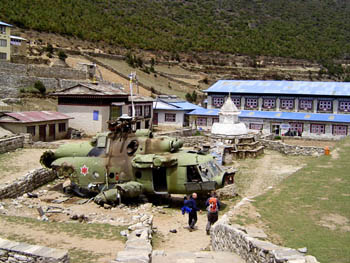 “We used all our walking gear and all the stuff we had to carry every day – well the porters did – to cover our rude bits. Stop watches, Mars bars. My dad’s got two bottles on the picture. He got nicknamed two bottles Pop. Honestly, it was such fun.
“We used all our walking gear and all the stuff we had to carry every day – well the porters did – to cover our rude bits. Stop watches, Mars bars. My dad’s got two bottles on the picture. He got nicknamed two bottles Pop. Honestly, it was such fun.
The crashed helicopter: scene of the 'disaster' photoshoot
But among the fun and frivolity, the serious intent of the expedition was always evident. “We had lectures on hypoxia and low oxygen levels. There’s a research group and we were tested in Kathmandu when we first arrived. We had to do all the bike stuff and wear the masks and everything, then we were tested in Namche Bazaar.
“We got there one day then we rest that day. Half the group is tested one day, half the next. We go on the [exercise] bikes and you are tested on whether your haemoglobin is increasing, watching how your heart is starting to adapt already because, by the end of the three days, you’re reasonably well acclimatised. Although you huff and puff up the hills, you don’t huff and puff half as much as when you arrived two or three days earlier.
“So, already your heart and your lungs are compensating. Your heart is beating stronger.”
From Namche, the party trekked the four days to Pheriche, 4,252m up (or 4,371m, depending on which source you use – perhaps it’s time for a new survey team to retrace Mr Everest’s steps), and four day’s walking into the Khumbhu valley. It’s also the site of the Himalayan Rescue Hospital. En route, a visit was made to Tengboche monastery, where many summiteers receive a blessing before making their way to base camp.
On the way to Pheriche, Jacqui had a chance encounter. She explained: “We gathered in our lodge, around a big yak-turd fire. I stepped outside and a small girl appeared.
“She said she’d been to base camp. ‘Did you enjoy it?’ ‘Yes, it was all right,’ she said, then she carried on down. Someone said: ‘Do you realise that was Rob Hall’s daughter?’.”
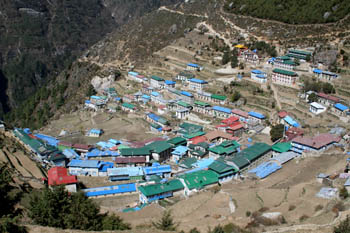 Rob Hall was the New Zealander, a guide, who died in the disastrous 1996 climbing season which was chronicled in Into Thin Air by journalist Jon Krakauer, who survived the ill-fated summit attempt. Rob’s daughter Sarah was born two months after his death.
Rob Hall was the New Zealander, a guide, who died in the disastrous 1996 climbing season which was chronicled in Into Thin Air by journalist Jon Krakauer, who survived the ill-fated summit attempt. Rob’s daughter Sarah was born two months after his death.
“I’m glad I didn’t know. I just treated her as an average little child. It was the first time she’d been since he died. Of course, she wasn’t born, so it must be ten, 11 years ago. She’d been with her mum [Jan Arnold].
“I’ve read Into Thin Air and I thought it was an amazing book and at the end, John Krakauer says: ‘It makes you never want to go near Everest again,’ and I thought, I’m sorry, you’ve completely inspired me. If I was ever going to be able to climb Everest I would definitely want to do it now I’ve read your book.
“That was a really surreal moment. I suppose I felt a little bit privileged to have spoken to her. Our paths just crossed so briefly. In the climbing world, he’s such a legend to anyone who’s interested in mountains and hills.”
The trekkers also met some of the summiteers at Pheriche. Jacqui told us: “We went for a walk round the hill towards the next village, called Dingboche, just a stroll to see what we were going to see on the way back, and our leader, from Jagged Globe, saw somebody she knew.
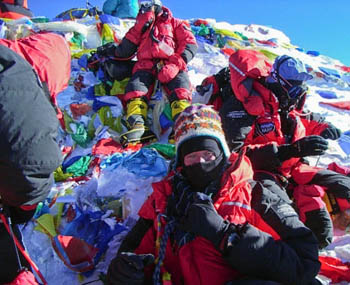 “They were all relaxing in a type of wooden conservatory that all the lodges have in Pheriche. She went in and asked if her group could join them. Some groups are stand-offish because they get colds and respiratory infections or even upset tummies.
“They were all relaxing in a type of wooden conservatory that all the lodges have in Pheriche. She went in and asked if her group could join them. Some groups are stand-offish because they get colds and respiratory infections or even upset tummies.
The Caudwell Xtreme Everest team on the summit of the world's highest peak
“But they said: ‘Yeah, yeah, bring them in!’ so I think they must have been really bored! When we got in, there were two groups. Jagged Globe had a summit group – a commercial group they were taking to the top and some of the Xtreme team were in there too.
“There were some other people who had come down that day. A woman with them had had a gastric bleed because of taking Brufen [a brand of ibuprophen] for altitude sickness, so she had been brought down and had to be flown out.
“So I was talking to some of the Jagged Globe group. I thought: I’m talking to a real climber.
“We chatted with them for ages then went back over. Next day was our testing day and they came over to us, which was really nice.”
At Lobuje, Jacqui’s father got a chest infection, one of four in the group to be suffering the same symptoms. The dry, cold air leads to shallow, fast breathing, which means the chest doesn’t get cleared. The mucous membranes in the respiratory tract dry up and leave the chest vulnerable to infection from bacteria and faecal matter blown up into the air from waste left by humans and animals.
Jacqui said: “My dad is a marathon runner; he’d been at the front the whole way. This day, walking up this flat area, he’s suddenly at the back. He woke up saying ‘I feel shit’.
“We gave him antibiotics straight away. Thankfully, he walked at the pace of this slow lady and I think he might have got a bit delirious at that point, because he was singing. I was thinking: Dad, why don’t you stop singing and keep your breath. I’m sure he was not quite right.”
It’s clear Jacqui has a great enthusiasm for mountaineering and all things jagged and pointy, despite her lack of experience. The next stage of the journey took her and her party into real Everest territory and the feeling real danger and risk were close at hand. It was a feeling that was to prove ominously accurate.
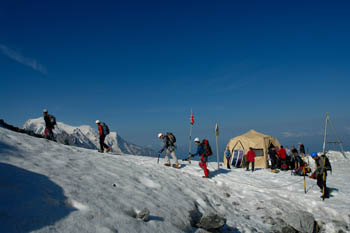 High up on the South Col, the summit team were called upon to put their medical expertise to good use, with the dramatic rescue of a Nepalese woman and further help for two stricken climbers who were close to death, suffering from acute mountain sickness and cerebral oedema – swelling of the brain which is fatal if not treated quickly.
High up on the South Col, the summit team were called upon to put their medical expertise to good use, with the dramatic rescue of a Nepalese woman and further help for two stricken climbers who were close to death, suffering from acute mountain sickness and cerebral oedema – swelling of the brain which is fatal if not treated quickly.
Things were not much better at base camp 5,357m up, in the shadow of the great icefall which marks the start of the route up Everest.
After Pheriche, Jacqui said, the terrain gets really barren. “Of course you’re getting close to these fantastic mountains and there are rocks everywhere.
“Some are the size of half a house, others are just normal ones you can see that have tumbled with weather: rain and ice. It wasn’t particularly icy, but we had hats and fleeces on. Then we realised this thing beside us was the glacier, but it was covered in rock.
“It was only when we got higher up, where the ice had fallen, that you could see that there was ice under it. I think a lot of the rocks come down the Khumbhu icefall and hit the ground and carry on down the hill.”
As well as the hazard of rock falls, the altitude started to take a toll on her. “I had another bad episode, with a really bad migraine-type headache, but it went after 40 minutes with some tablets, but when we got there, two women were already on Diamox [acetazolamide, a drug used to treat symptoms of acute mountain sickness], two Indian guys took Diamox just in case, but in a way, it must mask your symptoms.
“When we got to base camp another five people had to take it. A 70-year-old guy who had done altitude walking for years, said he thought his ‘ceiling’ must be starting to come down because he was starting to feel the effects and he had to go on Diamox.”
Despite this, the tests had to continue, with the usual aerobic step and exercise bicycle in use. “At base camp, we did exactly the same tests: a step test every morning, and we went on the bike again.
“We had blood tests. Every time we’d stopped for three days, we’d gone on the bike. The pattern was: two days’ walking, three days’ rest. Each time they’d test muscle and brain oxygen. They have some amazing piece of equipment they just stick on your skin and it can measure oxygen levels.
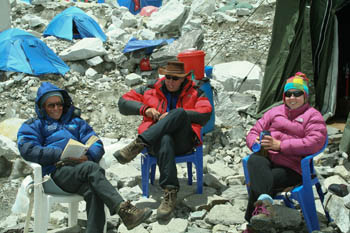 “I was too poorly. I got very bad sickness and diarrhoea when I got to base camp. They also do neurosciences such as: ‘Give me three words you can think of beginning with S.’ You’ve got a minute to do it.
“I was too poorly. I got very bad sickness and diarrhoea when I got to base camp. They also do neurosciences such as: ‘Give me three words you can think of beginning with S.’ You’ve got a minute to do it.
“They’ve already tested you in London, they’ve tested you in Kathmandu and now they test you at base camp and they test you when you get back down again. So you think of rude words to start. Mind you, I was like that in bloody London as well!”
Base camp is where the real impact of high-altitude sickness starts, Jacqui said. “For most people, the altitude takes six hours to take effect. For some reason, I always felt it immediately. Headaches seem to be the most common and most frequent. You get a mild headache and that can go to a severe headache that, even if you’ve taken strong painkillers you still can’t get rid of. So, it’s like having a migraine and not being able to do anything about it.
“People also suffer from chest infections. They told us before we went: take antibiotics for upset tummies and for chest infection. They have a supply of everything, but it’s just in case more people need it than they can cope with. So they tell us beforehand what you’re likely to get.
“One lady had gone on Diamox quite early but at base camp, the symptoms came on like she had a raging cold, so all her mucous membranes and her head, her throat, her chest, all just gave up and decided, that’s it, I’m swollen, I’m sore and I’m not working – and you can’t breathe.
“We stayed at base camp three days, which is a bad length of time. The trekkers who come up and go straight back down don’t get the effects. If you stay there for a week you acclimatise, but we had the worst of it. We arrived one day, test one day, free the next day.”
Among the casualties was the expedition’s major sponsor, John Caudwell, who has to be evacuated to lower altitude after succumbing to acute mountain sickness.
Base camp, she said, was like a ghost town. “I went round all the camps trying to get a cup of tea, but I think because of the time we were up there, a lot of people were down in the villages below, resting, feeding, fattening up and resting in the thick air.
“So there are lots of tents up there with no-one in them. That, or they’re sleeping. There’s hardly anyone around.”
Jacqui’s father’s illness meant an early departure from the camp. “My dad hardly ate and drank while he was at base camp, so came down a day early.”
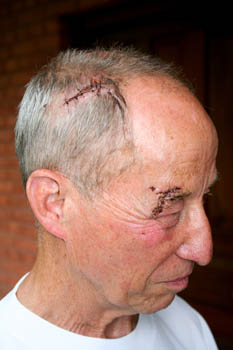 It was then that disaster struck. While descending, he was hit by a rockfall. This meant immediate evacuation.
It was then that disaster struck. While descending, he was hit by a rockfall. This meant immediate evacuation.
The gash on William's head sustained in the rock-fall accident
Jacqui said his injuries were serious: “He had a cut on his head, right down to the bone; blood everywhere. The poor Sherpa was crying because this was one of the people he was looking after.
“I got to him the next day. He was meant to fly at 6.30 in the morning; the helicopter was all ordered but the clouds had come down. We were walking down from base camp and I could see Dad.
“I gave him a big hug and then the helicopter came in. He was carried in. Some people helped me too, because I was still ill, and I got in with him.”
The journey was hair-raising. Onlookers later told Jacqui they thought they were going to die. The aircraft only just took off then hugged the ground. The air is so thin that gaining any height is difficult. The pilots wore oxygen masks during the 2½-hour flight to Kathmandu.
Jacqui recounts that for most of the flight, the craft was below the tree-tops and the pilots seemed to be having trouble fixing their location after the clouds came in again.
After landing at the military base in Kathmandu, a waiting ambulance took Jacqui and her father to a private clinic for treatment. “It was quite a culture shock: one minute we were in the wilderness at 5,000m and the next thing, we were back in Kathmandu. Both Dad and I struggled to answer even the most straightforward questions the staff were asking.”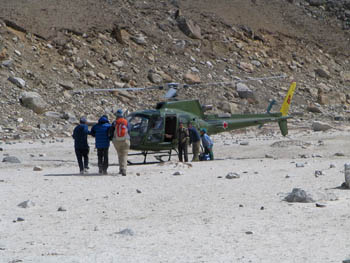
She says her father is fine now. A CT scan showed there was no internal brain bleeding and no skull fracture.
Jacqui's father is helped to the waiting helicopter
Despite the traumatic end to the expedition, Jacqui said she would definitely repeat the journey, and her father said he would go back at the drop of a hat.
The fruits of the medical research will take some time before they are put into practice. There is a huge amount of data to be collated and then published, but preliminary findings are due to be announced at a lecture in Dingle in the West of Ireland.
Jacqui said the most promising results surround individuals’ genes. “I don’t suppose they’ll know how beneficial it’s been medically until they correlate all the research. One guy did mention that they’ve identified a gene DD + II – I don’t know if they’ve known about it for a while or if they’ve recently found it – and you can be DD and at sea level quite a good athlete and with II, you’re good at altitude. You can also be D+I and be quite good at both.”
If the medical team can then use the genetic information to help those patients less able to cope with low oxygen levels, survival rates in intensive-care wards could increase.
Jacqui has no doubts about being part of the biggest high-altitude medical experiment in history. She told grough: “I feel really proud. It’s fantastic to be part of something that’s so big and so worthwhile.”
In years to come, patients all over the world may thank the men and women who put themselves through so much suffering and pain in the world’s highest research laboratory.
Rob
30 November 2007A brilliant account. I'm off to base camp next year, this gave me a valuable insight on what to expect.
Malc.S
24 September 2008A good read and pleased everything was ok in the end , especially the rockfall incident. I was at base camp in November 2006 and the approach is precarious. Whilst I was there, regular rockfalls occurred particularily to the left of the track after leaving the small ridge and descending to base camp.